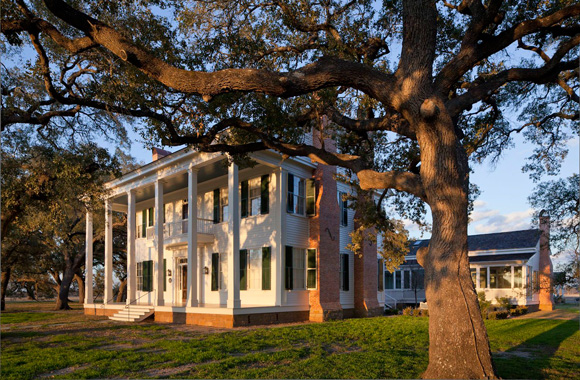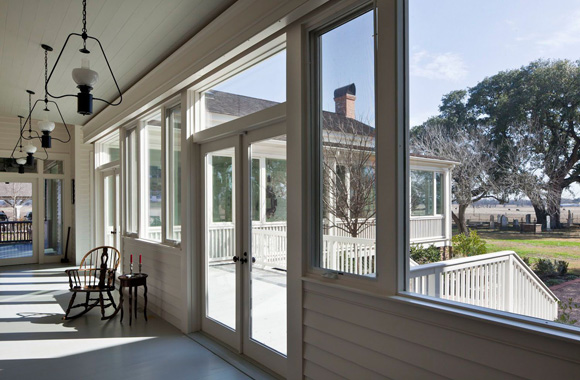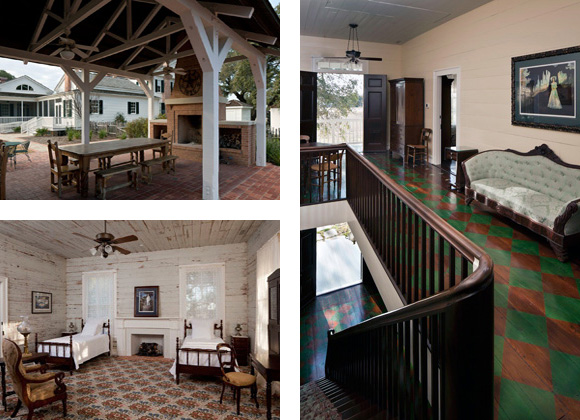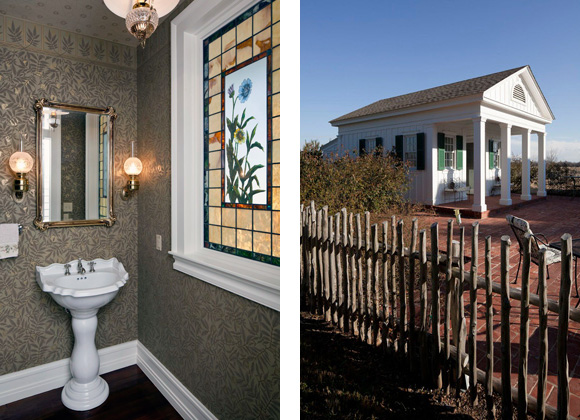Ancient Oaks, Wiley Hill Homestead
- Condition Assessment
- Historic Furnishings Plan
- Historic Interiors
- Material Conservation
- New Construction
- Residential
- Restoration/Rehabilitation
- Systems Integration
1856
Bastrop County, Texas
Recorded Texas Historic Landmark, National Register of Historic Places
____________________________________________________
Serene, peaceful, and sheltered by a grove of grand old oak trees, Ancient Oaks is imposing in scale and proportion. A site rich with place and spirit, the filtered light through the original windows is magical. Although many of its significant architectural details had been compromised over time, the house retained much of its vernacular detailing, revealing the original character and design intent for the restoration.
Our clients were driven by the connection to their ancestral home; their goals guided the program:
• Stabilize and restore the historic structure to create a friendly, livable home
• Design compatible additions to the main house and site including a master suite, large family living area, pool house, outdoor kitchen, and separate guest complex
• Preserve the property’s ancient oak grove and historic family cemetery
• Develop a plan and acquire period furnishings, finishes and accessories for the historic home
• Install state-of-the-art geo-thermal, fire, data, video surveillance, communication systems, LEED-appropriate insulation, weatherization, rainwater harvesting, and LED site lighting
Click here for more info from the Cedar Shake and Shingle Bureau →
Introduction
The restoration of the Abram Wiley (Wylie) Hill house is an academically pure, near museum quality revival of one of Texas’ great mid-19th century Greek Revival homes on its original site and by a member of the original family. A. W. Hill was a veteran of the Battle of San Jacinto and his sons served in Terry’s Texas Rangers. Now Wiley Hill’s great granddaughter x 3, Elizabeth Sartain, and her husband, David, have restored this early central Texas home and, through her involvement with the Bastrop County Historical Museum, open it for visitors.
History
A. W. Hill arrived in Texas on July 3, 1835 with a colony of 140 people from Alabama and Georgia. In 1836, he purchased half of the Jenkins league south of Bastrop (more than 2000 acres). The next year, he married Evaline Hubbard in Georgia and the couple returned to build a log house on the land and begin farming. By 1856, he was sufficiently prosperous to construct a fine Greek Revival home nestled in a grove of oak trees. After the Civil War, the family fell on hard times and eventually lost the property during the Great Depression.
Having heard stories of the family home all of her life, our client located the property in 1981. Climbing over barbed wire and trespassing, they walked around the house and family graveyard in awe, amazed by this tangible link to her family’s rich history. Ironically, the young couple joked about buying it some day.
Twenty-five years later, when considering retirement and a move from California to Texas, she and her husband contacted the owners to see if they would be interested in selling the property. To their delight, the answer was “yes” and the home returned to its original family!
Condition Prior to Restoration
Though livable, the house had deteriorated over the years. The adobe-like mortar in the sandstone foundation was severely eroded, causing the house to shift and sag. Roof leaks had damaged second floor wood ceilings and roof structure, and all of the original exterior cornice moldings had been removed. Three of the original four chimneys survived but they were shifting, creating structural problems. A late 20th century addition on the rear of the house was shifting also, allowing water to enter the original walls. Windows were deteriorated and had inappropriate wood shutters. Siding was severely weathered and rotted in areas, as was the front porch deck and much of the heavy wood framing of the walls. Previous termite infestations had attacked both the wood framing and interior sheathing. Inside, various changes made during the 1960s and 70s compromised the house’s historic integrity. Faced with these conditions, and still living in California, the new owners realized that the restoration would be complex and they needed professional assistance. They selected Volz & Associates, Inc. to provide architectural and interior restoration services.
Restoration
Initial efforts focused on site planning, historical research, and building documentation. A site topographic plan was generated and measured drawings were prepared in CADD format. A survey of the house was performed to define maintenance needs, missing original architectural elements, and original finishes. Historical information was collected from family members, National Register files, the Historic American Building Survey, local historians, and other sources. Through this process the property owners and former slave descendants met, compared notes, became friends, and shared feelings of family connection; both were amazed by the circumstances that brought them together after 150 years.
The first construction phase created a guest complex consisting of a guesthouse, swimming pool, pool house, and outdoor kitchen. These buildings provided housing for the family while the restoration was in process and continue to provide a recreation facility now that construction is complete. In design, the guest complex suggests a collection of the ancillary buildings so common on working plantations of the mid-19th century. It is sited to capitalize on views of the family cemetery and adjacent oak trees while providing privacy but convenient access to and from the historic house.
The second phase was the careful restoration of the historic house to its late 19th century appearance and the construction of an addition to accommodate contemporary lifestyles. The addition houses kitchen, breakfast, family and utility rooms, pantries, an office, and master suite, and is built on the site of the original kitchen wing. The design of the addition is contemporary but inspired by the historic house. Interior repairs to the historic house and the restoration of graining, marbleizing, stenciling, painted roller shades, solar chandeliers, wallpaper, and mid-19th century carpets were guided by historic family information, HABS documentation, and architectural evidence. All systems are state-of-the-art, including insulation, water collection, dual speed geo-thermal mechanical, security, remote monitoring, fire suppression, emergency generator, data, sound, and communications.
The major challenge of the project was the structural stabilization of the house. This process included removal of the 20th century addition, shoring and bracing, careful disassembly of the foundation and deteriorated chimneys, leveling and lifting the house, installation of new concrete footings, reconstruction of the sandstone footings and chimneys, lowering the house onto the footings, plumbing and leveling, then reinforcing and tying the structure together with concealed tie rods. Next, the rotting and termite-damaged wall and roof structure was repaired using epoxy techniques, as were the window sash and frames. Then, the original exterior cornice and other missing elements were reconstructed based on computer analysis of HABS photographs and architectural evidence.
Another challenge was to locate appropriate materials and artisans. Matching brick, salvaged from a 19th century church in Iowa destroyed by a tornado supplements the original brick. Sandstone for the footings was found in a near-by field. Sufficient quantities of antique pine had to be procured from several sources for repairs to floors, ceilings and walls and for new cabinetry. New pine for the addition was located in Mississippi after learning that Europe has cornered the market on American Yellow Pine. Custom reproduction carpets, lace curtains, and wallpapers came from England and the United States. A California artist hand painted the parlor’s reproduction roller shades. Austin artist Peter Hausmann reproduced period graining on doors, marbleizing and stenciling on the mantels, and hall floor stenciling. A source in Michigan provided custom reproduction and antique light fixtures, and several local cabinetmakers were found to fabricate new custom millwork.
Ancient Oaks now stands restored, occupied, and ready for another century and a half of service. Without the owner’s personal interest in the house, it is unlikely that it would have been restored so carefully, if at all, and this link to Texas’ past would have been lost.





